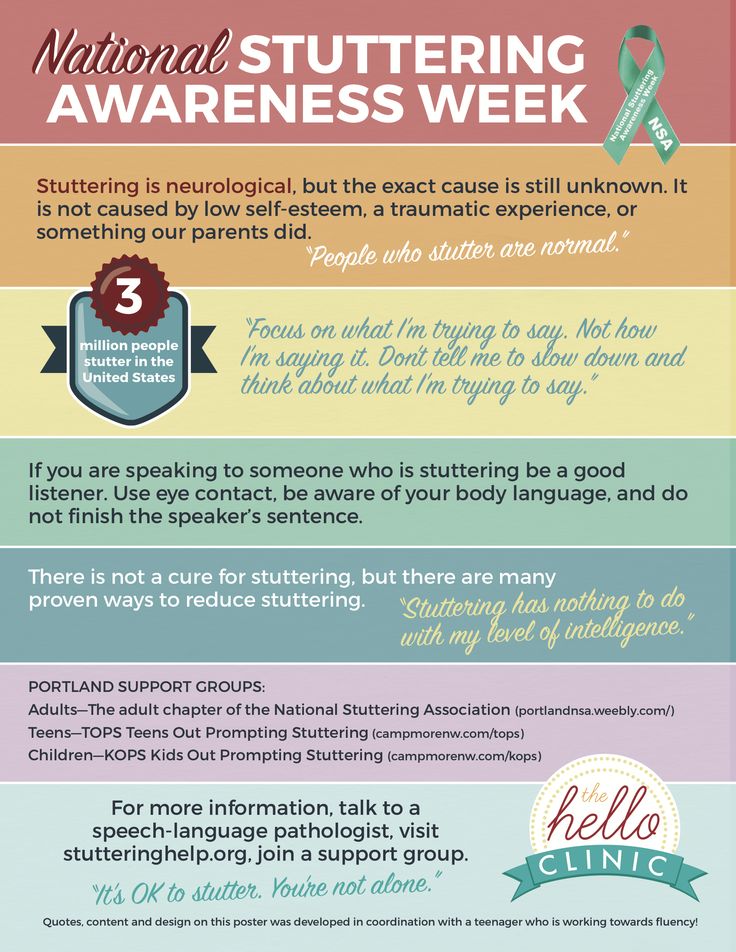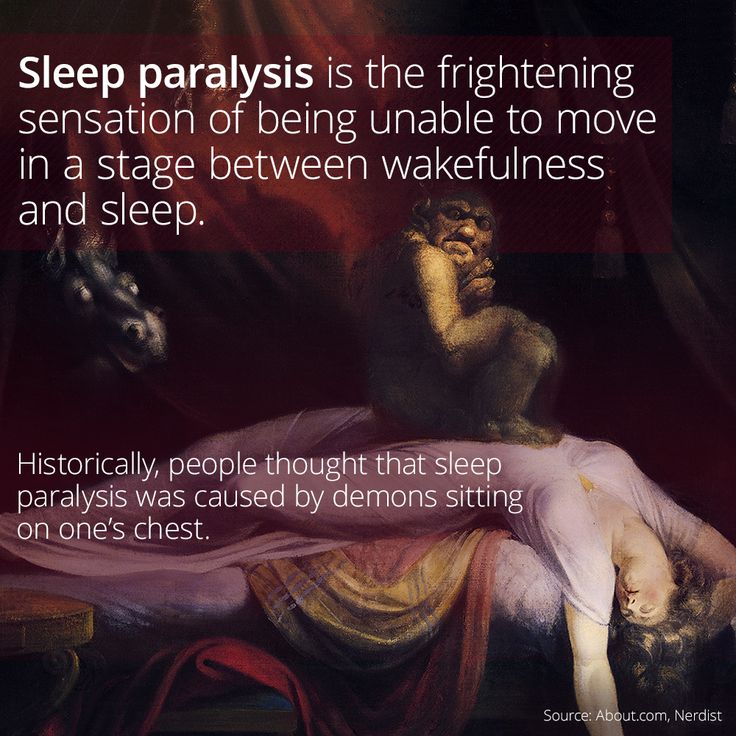People who stutter
Stuttering Explained - National Stuttering Association
Overview
- Stuttering is a difference in speech pattern involving disruptions, or “disfluencies,” in a person’s speech.
- People who stutter may experience repetitions (D-d-d-dog), prolongations (Mmmmmmilk), or blocks (an absence of sound), or can experience some combination of these sounds.
- The severity of stuttering varies widely among individuals.
- It’s estimated about one percent of the adult population stutters, which equates to almost three million people who stutter in the United States.
- Stuttering is about three or four times more common in males than females.
- There is no reliable, research-backed “cure” that works consistently, over time, and for all people who stutter.
- Although there is no simple cure for stuttering, people who stutter can learn to speak more easily, feel better about themselves and their speaking ability, and communicate more effectively.
Stuttering:
:: Explained ::
Causes
Treatment
Myths
Facts
Support
What Is Stuttering?
Stuttering is a difference in speech pattern involving disruptions, or “disfluencies,” in a person’s speech. The word “stuttering” can be used to refer either to the specific speech disfluencies commonly produced by people who stutter or to the overall communication difficulty that people who stutter may experience.
In addition to producing disfluencies, people who stutter often experience physical tension and struggle in their speech muscles, as well as embarrassment, anxiety, and fear about speaking. Together, these symptoms can make it very difficult for people who stutter to speak, and this makes it difficult for them to communicate effectively with others. There are as many different patterns of stuttering as there are people who stutter, and many different degrees of stuttering, from mild to severe.
What Causes Stuttering?
The precise causes of stuttering are still unknown, but most researchers now consider stuttering to involve differences in brain activity that interfere with the production of speech. In some people, the tendency to stutter may be inherited. Although the interference with speech is sometimes triggered by emotional or situational factors, stuttering is basically neurological and physiological – not psychological – in nature. In all other respects, persons who stutter are perfectly normal.
The most common type of stuttering (sometimes called developmental stuttering) usually develops of its own accord in childhood, most often between ages two and eight (although in rare cases it may begin much later). Roughly 4 to 5 percent of people experience stuttering at some time during their childhood. While the majority become fluent by the time they reach adulthood, stuttering may continue to be a chronic, persistent problem for other people who stutter.
Can Stuttering Be Cured?
Despite scientific breakthroughs in our knowledge about stuttering, there is still no reliable, research-backed “cure” that works consistently, over time, and for all people who stutter.
Many individuals benefit from various forms of speech therapy and from support groups like the National Stuttering Association®. Meanwhile, researchers are experimenting with electronic devices, pharmaceuticals, and other still-unproven techniques and alternative treatments.
It’s unrealistic to expect that any treatment will make stuttering completely disappear. Despite common myths, there is no therapy, device, or drug that is effective all the time or for all people who stutter. Methods that appear to benefit some individuals may not work for others, and relapses are common. Controlling stuttering is a long-term project that begins with acceptance of one’s stuttering and requires considerable patience and understanding.
How Common Is Stuttering?
It has been estimated that about one percent of the adult population stutters. This would amount to almost three million people who stutter in the United States alone. Stuttering is about three or four times more common in males than females.
This would amount to almost three million people who stutter in the United States alone. Stuttering is about three or four times more common in males than females.
Stuttering Is Variable
The severity of stuttering varies widely among people. It may also vary in the same individual from day to day and depending on the speaking situation. Saying one’s name and speaking to authority figures may be particularly difficult. For some people, fatigue, stress, and time pressure can increase their tendency to stutter. When people who stutter feel compelled to hide their stuttering, it generally becomes worse.
Patterns of stuttering behavior also vary. People who stutter may experience repetitions (D-d-d-dog), prolongations (Mmmmmmilk), or blocks (an absence of sound), or can experience some combination of these sounds. Some who stutter will also try to avoid stuttering by pausing before words, substituting words, and interjecting phrases such as “you know,” “well actually,” “um,” etc. , whenever they anticipate a moment of stuttering. As a result, the person may create the false impression of being hesitant, uncertain, or confused.
, whenever they anticipate a moment of stuttering. As a result, the person may create the false impression of being hesitant, uncertain, or confused.
A job interview may be the single most difficult speaking situation a person who stutters will ever encounter. Stuttering is likely to be at its worst. Therefore, the degree of stuttering at the interview should not be used to predict how the person will actually speak on the job.
What Help Is Available?
Although there is no simple cure for stuttering, people who stutter can learn to speak more easily, feel better about themselves and their speaking ability, and communicate more effectively.
Because stuttering typically starts between the ages of 2½ and 5, early intervention is the most effective way to help children overcome their speaking difficulties. Therefore, it is important for parents and pediatricians to seek an evaluation by a qualified speech-language pathologist as soon as they become concerned about a child’s stuttering.
School-age children, adolescents and adults can also benefit from treatment. For these individuals, treatment is designed to help them learn to manage their stuttering so it is less disruptive to their communication. Treatment can also increase their speech fluency as appropriate, and improve their self-esteem and their self-confidence so they can communicate more freely and effectively.
Support Groups for People Who Stutter
The National Stuttering Association provides over 200 support groups for adults, kids, families, and teens. During these monthly meetings, conversation flows freely without fear or embarrassment and no one feels alone. It’s another way to build self-confidence, practice speaking in a safe environment and explore new ways to cope with stuttering. Find the NSA® Chapter nearest you.
Previous: Overview
Next: Causes
Facts About Stuttering - National Stuttering Association
People who stutter are normal, they just have difficulty producing sounds and words fluently. The more we understand stuttering, the better we can educate others about it. The NSA® has partnered with leading stuttering specialists and researchers to provide accurate information about stuttering. Here are a few facts about stuttering:
The more we understand stuttering, the better we can educate others about it. The NSA® has partnered with leading stuttering specialists and researchers to provide accurate information about stuttering. Here are a few facts about stuttering:
Stuttering:
Explained
Causes
Treatment
Myths
:: Facts ::
Support
Stuttering usually begins in childhood, between the ages of 2 and 5 years.
Stuttering is a speech pattern involving disruptions, or “disfluencies,” in a person’s speech.
Stuttering can begin gradually and develop over time, or it can appear suddenly.
When people stutter, they feel like they have lost control of their speech mechanism. This sensation of loss of control can be disconcerting and uncomfortable, and it can lead to embarrassment, anxiety about speaking, and a fear of stuttering again.
Stuttering is a genetically-influenced condition: most of the time, if there is one person in a family who stutters, there will be another person in the family who also stutters.
Stuttering is associated with differences in the brain; it is not just a behavior that children learn or pick up from listening to other people who stutter.
Stuttering is more common among males than females. In adults, the male-to-female ratio is about 4 to 1; in children, it is closer to 2 to 1.
It’s estimated about 1% of the world’s population stutters, though about 5% of children go through a period of stuttering.
As many as 80% of young children who begin to stutter ultimately stop stuttering. Those who continue to stutter into the school-age years are likely to continue stuttering in some fashion throughout their lives.
Stuttering varies significantly over time: Sometimes, people will have periods in which the stuttering appears to go away, only to have it return. This variability is normal.
People who stutter often try to avoid stuttering, perhaps by trying to speak quickly, by forcing through moments of stuttering, or by not speaking at all when they fear that they might stutter. These behaviors can actually increase the likelihood that more stuttering will result, and they lead to a greater impact of stuttering on the person’s life.
These behaviors can actually increase the likelihood that more stuttering will result, and they lead to a greater impact of stuttering on the person’s life.
Stuttering also varies across situations: sometimes people stutter a lot, and sometimes they stutter a little. Again, this variability is normal.
For people who stutter, the observable disfluencies are not the most important part of the condition. Instead, it is the impact on their lives that causes the most concern. Therefore, speech therapy for stuttering should focus on more than just fluency; it should also account for the ways that stuttering affects the speakers’ life.
These are just a few facts about stuttering. It’s important to know the facts about stuttering because it will help to dispel the common Myths About Stuttering.
Previous: Myths
Next: Support
Famous people with stuttering: which of the celebrities stutters
On October 22, the world celebrates the International Day of Stuttering People. Ivona has collected inspirational stories of celebrities who stutter or still stutter.
Ivona has collected inspirational stories of celebrities who stutter or still stutter.
- Bruce Willis
Celebrities with Stuttering: 14 Success Stories
As a child, Willis bore the offensive nickname Buck-Buck - so classmates parodied the boy's stuttering. The actor began to stutter as a teenager, probably due to the shock caused by the divorce of his parents. However, speech defects only spurred Bruce Willis: he began performing in the school theater, then he seriously thought about the career of an actor, because only on stage there was no trace of stuttering.
- Sir Anthony Hopkins
Celebrities with Stuttering: 14 Success Stories gettyimages.com
Dyslexia and stuttering greatly complicated Hopkins' learning of school material and making friends. Therefore, the boy devoted all his time to art, mainly to music. At the end of school, the young man decided to choose an acting path, but was embarrassed by speech defects. He was supported by the actor Richard Burton, and over time, already in acting classes, Anthony Hopkins himself discovered that, pronouncing the words in a singsong voice, there was no trace of stuttering.
He was supported by the actor Richard Burton, and over time, already in acting classes, Anthony Hopkins himself discovered that, pronouncing the words in a singsong voice, there was no trace of stuttering.
- Emily Blunt
Celebrities with Stuttering: 14 Success Stories gettyimages.com
The future actress began to stutter at the age of 7, and in adolescence the defect reached its peak - Blunt preferred to be completely silent than to speak, terribly stammering. The school teacher and the theater scene helped the girl to get rid of the defect: parodying accents and cartoonish voices, Emily was surprised to find that stuttering was going away. In many ways, it was this teenage shock that determined the fate of the actress. Emily Blunt herself jokes that this stuttering chose this path for her.
- Rowan Atkinson
Celebrities with Stuttering: 14 Success Stories gettyimages. com
com
In life, the famous Mr. Bean never managed to overcome his stuttering. However, a talented actor is so immersed in each of his roles that during work, the speech defect disappears on its own. If he fails to pronounce a word even on stage or on set, Actinson turns a slight stutter into a highlight of his character.
- Julia Roberts
Celebrities with Stuttering: 14 Success Stories
The actress's stuttering is hereditary; her father, mother and brother suffered from this speech defect. Roberts was helped to overcome the problem by her stepmother, who made every effort to put the children in the correct speech and pronunciation, and get rid of the southern accent. Home performances, which were regularly staged in the family of the actress, also had a significant impact.
- Samuel L. Jackson
Celebrities with Stuttering: 14 Success Stories gettyimages. com
com
Already being an adult and accomplished person, an actor of world renown, some of the words of Samuel L. Jackson cause difficulties. In work and life, this does not bother him too much, since he has chosen his own way to deal with a speech defect: if a word or sound makes him stutter, he simply tries to express his thought in a different way, avoiding triggers.
- Nicole Kidman
Celebrities with Stuttering: 14 Success Stories gettyimages.com
The Oscar-winning actress claims she's outgrown her stutter. Classes at the ballet school helped, and then acting. The artistic nature of Kidman was able to overcome the speech impediment, and made her one of the most desirable women in Hollywood.
- Gerard Depardieu
Celebrities with Stuttering: 14 Success Stories gettyimages.com
Gerard Depardieu had many obstacles to his career: upbringing, lifestyle and stuttering. Having set out to become an actor, the young man turned to doctors, and they treated him, believing that the causes of the defect were purely physiological. Music saved Depardieu - daily listening to Mozart saved the actor from stuttering.
Having set out to become an actor, the young man turned to doctors, and they treated him, believing that the causes of the defect were purely physiological. Music saved Depardieu - daily listening to Mozart saved the actor from stuttering.
- Marilyn Monroe
Celebrities with Stuttering: 14 Success Stories wikipedia.org
The hoarse and breathy speech became Monroe's trademark, along with a seductive mole on her cheek and blond hair. In fact, this manner of expressing one's thoughts is a way to overcome stuttering, which aggravated Marilyn in stressful situations for the rest of her life.
- Elvis Presley
Celebrities with Stuttering: 14 Success Stories gettyimages.com
The King of Rock and Roll suffered from a childhood stutter. A caring mother and music helped him cope with a speech defect, performing which the singer simply forgot about everything in the world, including stuttering.
- Somerset Maugham
Celebrities with Stuttering: 14 Success Stories wikipedia.org
One of the highest paid writers of the 30s began to stutter due to a nervous shock - at the age of 10 he became an orphan. His uncle was his guardian, but the boy did not receive tenderness and attention. Maugham also had to give up his church career, who needs a stuttering priest? Somerset Maugham failed to overcome the speech defect, but this did not prevent the whole world from hearing his voice, albeit in book binding of brilliant works.
- Lewis Carroll
Celebrities with Stuttering: 14 Success Stories wikipedia.org
The writer was deaf in one ear, suffered from constant insomnia and stuttering. However, these ailments did not prevent him from making a good teaching career at Oxford, singing well, communicating with others and, of course, becoming the author of the legendary “Alice”, whose adventures still excite both children's and adult minds.
- Sir Winston Churchill
Celebrities with Stuttering: 14 Success Stories wikipedia.org
The politician is one of the UK's most charismatic orators. His speeches were listened to with bated breath, and a well-placed voice, refined gestures and facial expressions only added to his words of impressiveness. However, in his spare time, Churchill tirelessly repeated tongue twisters in order to overcome a stutter that he had suffered from since childhood. He sometimes used his speech defect to attract the attention of the audience, and in his free time he diligently tried to overcome it.
- King George VI
Celebrities with Stuttering: 14 Success Stories wikipedia.org
The events of the film "The King's Speech!" are not fiction at all - the British King George VI was extremely shy and stuttered terribly. Proven methods did not help, smoking and pebbles in the mouth did not help, each public speech was torment for the monarch, during which he simply burned with shame. Success in ridding the king of stuttering is attributed to Sir Lionel Logue, a speech therapist from Australia, who developed a set of vocal and breathing exercises for George, and also helped him prepare for every public speech with the help of tongue twisters. Thanks to Logue's therapy, King George VI got rid of not only his stuttering, but also his fear of speaking, stammering only occasionally. The monarch himself joked that he did it on purpose so that the people would believe that he really was talking.
Success in ridding the king of stuttering is attributed to Sir Lionel Logue, a speech therapist from Australia, who developed a set of vocal and breathing exercises for George, and also helped him prepare for every public speech with the help of tongue twisters. Thanks to Logue's therapy, King George VI got rid of not only his stuttering, but also his fear of speaking, stammering only occasionally. The monarch himself joked that he did it on purpose so that the people would believe that he really was talking.
Previously, we told you which celebrities suffer from mental disorders.
Want to be the first to know important and current news? Subscribe to Ivona.bigmir.net :) on Facebook and Instagram.
Read Ivona.ua on Google News
A person with stuttering can be the soul of a company
Olga Azova, director of Logomed Prognoz Medical Center. Photo from the site logomedprognoz.ru What is stutteringRussian speech therapists consider stuttering to be a pathology of speech, in which the external design of the utterance is disturbed.
 Stuttering is characterized by frequent repetition or prolongation of sounds, stops, hesitancy in speech, rhythmic failure. Sometimes stuttering is accompanied by logoneurosis, in which a person is “afraid” to start talking.
Stuttering is characterized by frequent repetition or prolongation of sounds, stops, hesitancy in speech, rhythmic failure. Sometimes stuttering is accompanied by logoneurosis, in which a person is “afraid” to start talking. Two characteristics of people with stuttering
– There is still a strong stereotype in society that a person with stuttering is “with problems”. Often they are shunned, they try to "not get involved" in conversations. What is special about a person with a stutter?
– To be honest, I didn't know that such a stereotype still exists in society.
People with stuttering are generally normal. There are perhaps two features.
External manifestation in speech - hesitation, creating certain difficulties in maintaining a conversation. And the features of the organization of speech, which are based on neurosis with various psycho-emotional, behavioral and somatic symptoms. Often it is the neurotic and psychological state of a person that can create difficulties in communication, and not speech stutters themselves.
Let me give you an example: in my circle of friends there was a friend with a fairly strong degree of stuttering (stammering), but this did not prevent him from remaining the soul of the company, a merry fellow with a wonderful sense of humor, with a stock of witty anecdotes and stories.
Stuttering, depending on the causes of occurrence, is neurological and neurotic. In case of neurological stuttering articulation problems are associated with dysarthria - organic dysfunctions of the organs of speech - palate, tongue, etc. Children usually start talking later, they are characterized by general slowness.With neurotic stuttering, the terms of development of speech and motor functions are normal, there are no pronounced neurological disorders. This type of stuttering is usually caused by stress. The starting point can be fright, fear, a psychotraumatic situation. Photo from the site klix.ba
People with a neurotic type of stuttering are united by the fact that in a familiar environment they speak clearly, without hesitation, but in stressful situations they may not be able to say anything at all. This temporary "muteness" occurs due to speech spasms. They also have a fear of speech (logophobia).
This temporary "muteness" occurs due to speech spasms. They also have a fear of speech (logophobia).
Stressful situations for a stutterer, from the point of view of the majority, can be “trifle”: a conversation with a stranger, a targeted question in a public field. Almost all children with a neurotic type of stuttering are afraid to answer “at the blackboard”, especially to unexpected questions. Adults are afraid of speaking, public speaking, sudden questions - in an unfamiliar audience. This is how the neurotic mode of behavior manifests itself in general.
– I was surprised to learn that there are many singers who stutter, and many have overcome stuttering precisely because of their profession. And it happens that a person sings normally, but speaks with a stutter. How to explain such a phenomenon?
- Singing and speaking in a chant - and there are corrective techniques.
It is believed that during singing there are practically no spasmodic delays. In fact, the self-correction of stuttering is due not so much to the fact of singing, but to other factors (the tempo of the music, singing solo, duet or in a choir, with and without musical accompaniment). But success here, above all, depends on the degree of stuttering. Its complete elimination by "singing" is observed only with a mild degree.
In fact, the self-correction of stuttering is due not so much to the fact of singing, but to other factors (the tempo of the music, singing solo, duet or in a choir, with and without musical accompaniment). But success here, above all, depends on the degree of stuttering. Its complete elimination by "singing" is observed only with a mild degree.
So this is not a phenomenon - there are simply general patterns that speech therapists use to correct stuttering in speech and singing.
- About the famous literary character Erast Fandorin, the author Boris Akunin writes that he began to stutter after a shell shock, but at the time when he was investigating, this defect disappeared. Does it happen or is it a fantasy?
- Since the nature of neurotic stuttering is of a stress-traumatic nature, it is realistic that Fandorin could begin to stutter after the concussion. One of the methods of stuttering correction is psychotherapy. If we consider the reincarnation of Fandorin in other characters during the investigation as a kind of psychotherapy, then, apparently, yes, this could be.
Do you like being interrupted? Photo from kt-hypnotherapy.co.uk
– What should a person do if they come to him with a household question, say, “how to get to the subway?” handled by a person with a stutter? Wait until he says everything? Interrupt - “I already understood”, predict? How not to offend and help if this is an unfamiliar passerby? It's understandable that he's shy.
- Can you name at least one person who will say: I like being interrupted? No one likes it, so when communicating, be patient. Just like with any other person. We are waiting for the end of the statement - we answer. We offer no other help.
Any attraction of attention to any defect gives a person a reason to somehow start to hide it, “camouflage”. But it is impossible to hide it, but it is possible to strengthen stuttering, due to the neurological nature.
– How should employees from the service sector deal with stuttering people – salespeople, doctors, officials with different documents, etc. After all, there are queues everywhere, people are even more nervous. Do you have any tips or instructions for this?
After all, there are queues everywhere, people are even more nervous. Do you have any tips or instructions for this?
- We have just begun to actively learn to be tolerant, so such instructions are hardly available anywhere.
But I still insist on general rules of communication. All you need is the same as always, just a little more: close attention, good disposition, a lot of patience, a good attitude, a smile, a desire to help.
Give a person with a stutter the opportunity to say what he wants, and you will see - he can speak.
I once had such a case “in the service sector”. At the checkout, somewhere on top, it says: "tape does not work." Of course, I didn’t see it when I put the products on the tape. The cashier made an irritated remark. It was clear that I was not the first who did not see the ad.
I was in the mood for a calm conversation, I answered: “You don’t need this announcement, it’s not visible, just let everyone know that the tape is not working. ” My answer added expression, as if the cashier was waiting for these words: “I’ve been talking all day!”
” My answer added expression, as if the cashier was waiting for these words: “I’ve been talking all day!”
And once again I calmly: “What to do is part of your job. For example, I work with non-speaking children, more often with autism. Can you imagine how many times I need to repeat? I do it with desire, because this is my job, it won’t work out differently.”
And here the cashier looked at me really attentively and started asking a lot of questions about her child that she was worried about! Very polite and very calm.
10 golden rules of communication Photo from smcspeechpathology.com.au
There are speech rules that are written for stutterers themselves, but they will fit in any situation for all people . They were written for stuttering schoolchildren by speech therapists E.L. Pellinger, L.P. Uspenskaya, here they are:
- Think first, then speak.
- Speak at a calm pace.
- Always speak as you exhale.

- Highlight vowels in words.
- Pronounce the words in a sentence together.
- Pause at the end of each sentence.
- Divide long sentences into semantic segments.
- After a semantic segment, pause.
- In each sentence, highlight the main words in terms of meaning - make logical stresses.
- When talking, look calmly at the interlocutor.
– What is the best way to organize such communication at work? Is it worth translating communication with a stutterer into a written version - mail, instant messengers ..., or is it necessary to stimulate verbal communication?
- It seems to me that it is necessary to act according to the situation, showing tact and kind attention. A person with a problem will tell you how to do it: mail, instant messenger or verbal type of communication. In many cases, with a mild degree of stuttering, there should be no problems at all on either side. And if they arise, it's not stuttering, but something else.
– There are cases when a new colleague with stuttering, having got used to it, practically stopped stuttering at work and forgot about him that there is such a problem.
- Not stuttering disappears, but stress. This happens as soon as a person has adapted to the team. Agree, for any person this is not an easy task. And this process is two-way. Although it is still more difficult for the applicant.
But it is not at all necessary to be “friends” with a person because he stutters. At work, it is important that the usual ethical standards are respected: courtesy, respect, the opportunity to express one's opinion, so that people say hello. The main form of support is a little more kind attention and time to communicate with him than usual.
Although there are different groups. If a person with stuttering experiences difficulties here, it is better for him to seek professional psychological help.
And about love Photo from scrubbing.in
– What about love relationships? Here, for example, people met on the Internet, corresponded, and everything was fine, but when they meet, it turns out that he or she stutters.
– So, we must learn to understand each other without words (laughs)! Again a personal example: my husband has a stumble, a stutter in conversational speech, more often outside the home. And I myself don’t fix it at all, you can say, I don’t hear it.
My husband's close friend stutters. Once, about 30 years ago, he also told his future wife a "secret" - that he had a stutter. And here we are, still together.
A friend of ours had a young man who stuttered in a rather severe form. The group for the correction of the disorder was supervised by a young speech therapist. After some time, the speech therapist married him.
My husband's stuttering was stopped. A child was born. At home they spoke using corrective techniques in chant. My son did not have a stutter. Also twenty-five years of marriage.
My son did not have a stutter. Also twenty-five years of marriage.
Treatment: music, massage, breathing, relaxation
Photo from medicalnewsbulletin.com– Do such people need silence? Or vice versa, you have to talk, talk, sing, etc.?
– In speech therapy, there are several directions, schools of stuttering correction. These are complex rehabilitation systems that are designed for medical and preschool children's institutions. There is also such a corrective technique - the silence mode. And there are sessions of emotional stress therapy. The sessions themselves are held in a situation of public speaking.
Thus, there is both silence and speaking. The choice of the system by which stuttering will be corrected is important. But it is impossible to give advice in isolation from the very methodology that was chosen for the correction of stuttering.
Perhaps it makes sense to talk about the organization of a special protective regime for stutterers, about the formation of a sufficiently clear daily routine, within which there may be a regime for limiting speech, creating conditions for regulating the emotional state and directly stuttering correction classes, which include developmental exercises and rhythmization of movements, the formation of speech breathing, voice skills, the development of the prosodic side of speech, etc.
The patient necessarily cooperates with several specialists, including a neurologist, psychologist, speech therapist, massage and physical education specialist. You can use instrumental methods of work. At the center, we actively use the BFB-logo simulator to develop and automate diaphragmatic breathing, which is necessary as a support when speaking, so that speech convulsions do not occur for as long as possible, as well as prolonged speech expiration and pronunciation of sounds when stuttering is combined with dysarthria.
One of the wonderful and high-quality methods of work is massage, both general and speech therapy in a relaxing type, which can be combined with physiotherapy procedures. For example, amplipulse therapy helps to relax the muscles of the face and neck. Bioacoustic correction (BAC) is an innovative method of instrumental treatment of many diseases: neurological, psychosomatic, mental, vegetative.
Listening to music that is synchronized with the electrical activity of the neurons in the patient's brain helps, in combination with other procedures, to solve the problems of stuttering.
Psychotherapeutic sessions with a psychologist or psychotherapist are important.
If we return to the question of the protective regime, then for families where neurotic stuttering has debuted, and the child has early speech development, I recommend spending a year on vacation.
The child takes turns going on vacation: with his mother - to the sea, with his father - to the mountains, with his grandmother - to the country house, with his grandfather - to the village, with his aunt - to a sanatorium.
This is how you get relaxation and keep silence as much as possible.
Stuttering is independent of age, but is more common in preschoolers. It may first appear during the formation of speech skills. In puberty, there are relapses, most often due to neurosis. According to statistics, stuttering is three times more common in boys than in girls.No prohibitions on the profession Photo from hasa.org
– Are there absolute prohibitions, taboos in the profession for people with pronounced stuttering?
– There are no absolute prohibitions, and nothing is impossible.














